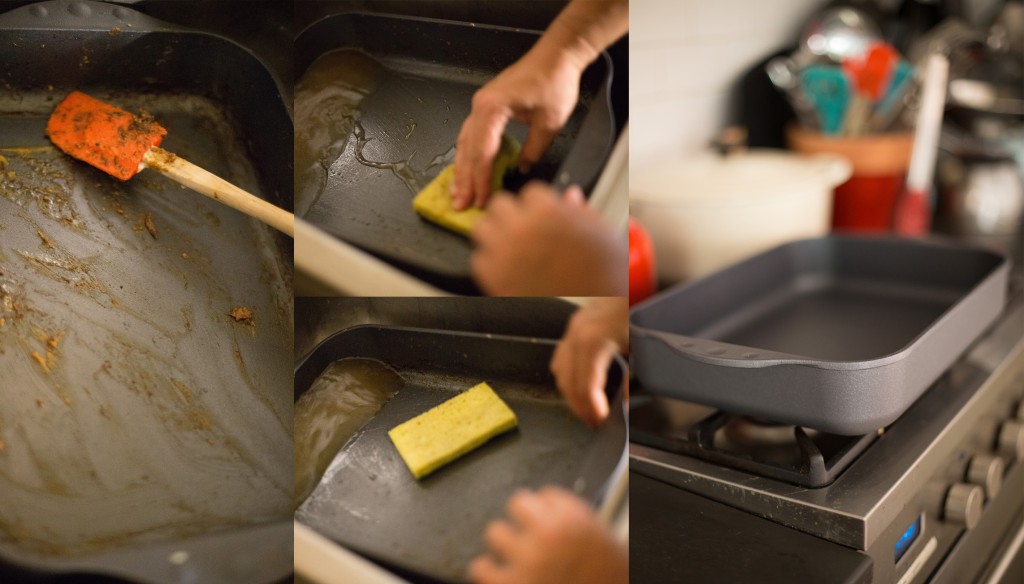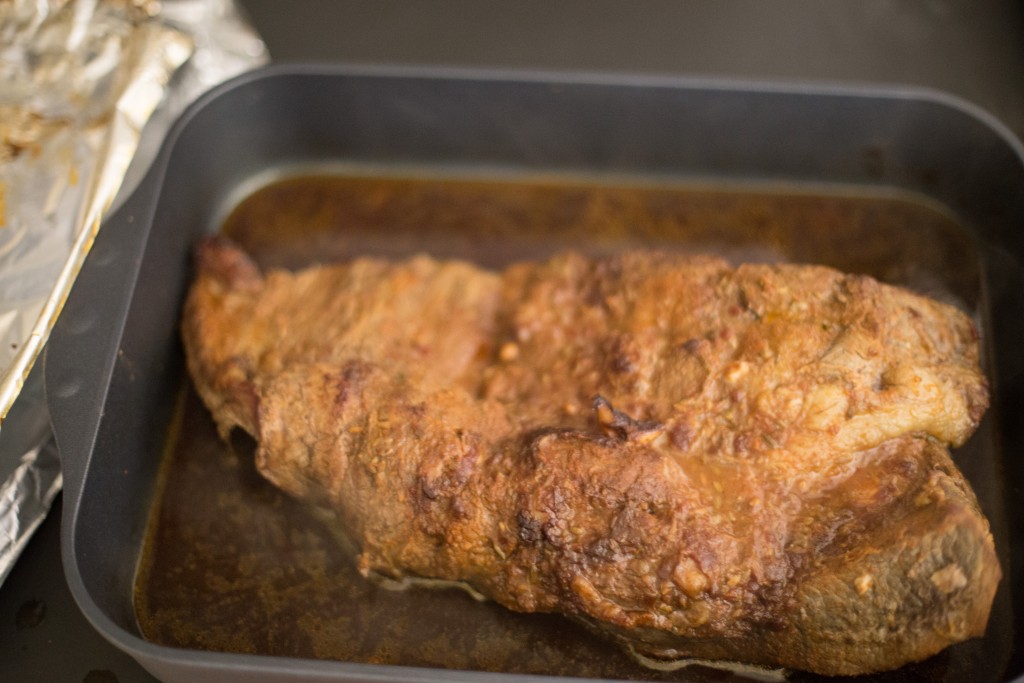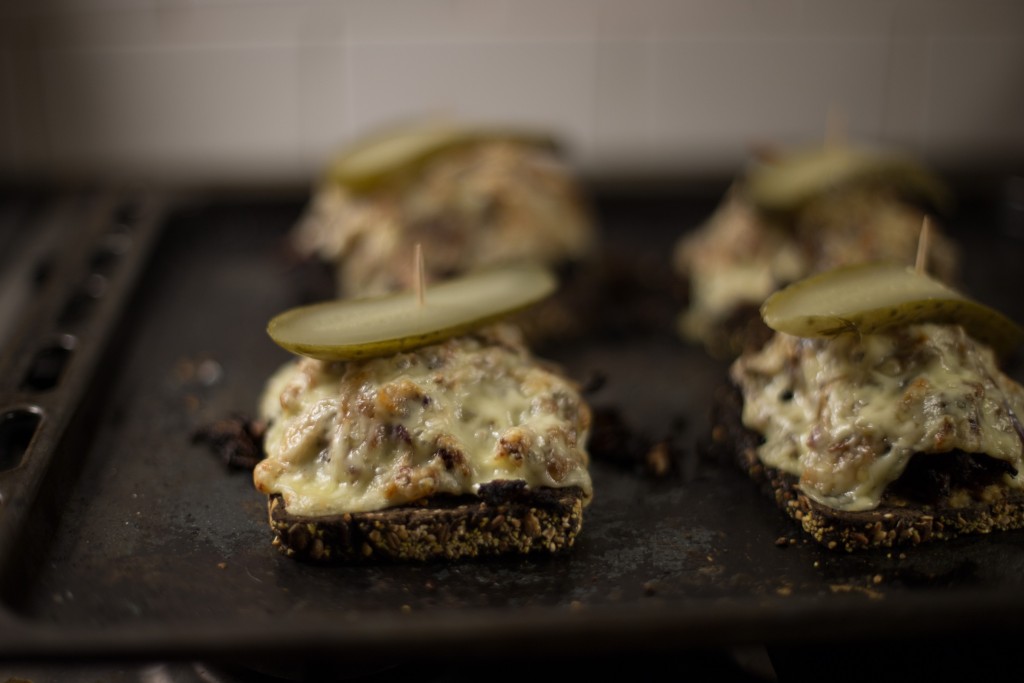I decided a great test for the Swiss Diamond Deep Roasting Pan would be making a large beef brisket. I knew that this would be cooked low and slow in the oven over several hours, and include a sticky sauce at the end which could be a trial for the non-stick surface made with diamonds. Swiss Diamond claims that each of their pans have as much as 200,000 diamond crystals and are used because they have incredible hardness and durability, conduct heat better than metals and are also naturally non-stick.
First Impression
My first impression was how sturdy the pan felt. It has a rough texture and I liked the deep sides. This would be a big help at Christmas time, or for any time you may be cooking on a large scale. It would be a great pan for a large casserole or lasagna to feed a crowd. Saying that, I would be just as happy cooking some roast potatoes in it for my family of four.
The instruction manual has helpful large photos – a key feature is that a lower temperature may be used due to the conductive heat element. This is good advice for slow cooking, which can be notoriously tricky. It is also good to know that metal utensils can also be used with it, which is very rare for the majority of non-stick cookware.
Using the pan from marinating to oven to stove
A large beef brisket fit perfectly into the pan. I left it in the pan overnight in my refrigerator to marinate with the dry rub. Despite being so sturdy, the pan was not too heavy or cumbersome to lift in and out of the the fridge or oven during cooking when I checked on the meat.

the brisket marinated with the dry rub of spices. The huge 2 kilo cut fit perfectly inside the pan
I found that the internal temperature of my brisket was reached far quicker than expected. This could’ve been due to the conductive heat element of the Swiss Diamond pan. I simply lowered the heat to 110C for the remainder of cooking time and held it at that temperature. The brisket also browned very nicely early on, which is one of the key features Swiss Diamond claims.
After the meat came out of the oven, I let it rest in the pan and cool completely. I prefer to pre-cook foods like this several hours before needed, and then reheat in the pan right before serving. This is a great way of avoiding that hectic rush and stress right before plating up dinner. I placed the pan with my sliced brisket on the stove top onto a low direct flame to warm, and that worked perfectly.
Cleaning after use
The pan was a dream to clean. It simply needed a wipe with a sponge and every last bit of sauce and fat disappeared.

Dirty to Clean in seconds! The dried sauce and fats came off faster than I expected
The Verdict
This pan is the Rolls Royce of roasters. It will cook your food evenly, brown it beautifully (look at the results below!) and clean with ease. With this type of equipment, you get what you pay for, and this pan will last a lifetime. As a guide, the manufacturer’s claims are true – I advise to reduce the cooking temperature by an average of 10-15 degrees.
Beer Braised Beef Brisket Recipe

Ingredients:
- A 2kg rolled beef brisket (I find the ones that have been rolled have already been trimmed nicely by the butcher and are the most even in size)
- 1 tbsp each flaky sea salt, sugar, smoked paprika and garlic powder
- 2 tsp cracked black pepper
For the BBQ sauce/braising liquid:
- 1/3 cup honey, maple syrup or molasses
- 1/3 cup ketchup
- ¼ cup soy sauce
- ¼ cup rice wine vinegar
- ¼ cup Worcestershire sauce
- juice and zest of one orange
- 1 tablespoon fennel seed
- ½ bottle of beer
Instructions:
- Cut the string off of the brisket and remove the paper it is wrapped in.
- Combine the salt sugar, paprika, garlic powder and pepper in a bowl. Sprinkle all over the brisket and marinade overnight if possible, but for at least an hour.
- Make the braising liquid: Place everything except the beer in a saucepan and bring to the boil. Reduce the heat to a low boil and reduce by a third, about 10-15 minutes. Set aside half to use as a BBQ sauce later. Take the brisket from the fridge and let come to room temperature. Pour half of the braising sauce over the brisket, followed by the beer.

- Heat the oven to 130C. Cover the brisket with foil, then cover the pan with foil again.
- Cook the brisket in the middle shelf of the oven for approximately 4 hours. (Aim for 1 hour per 500g). To be very accurate, use a meat thermometer to check periodically, and at those times also turn the meat over. Add more beer if it looks like the pan juices are evaporating. Once it reaches an internal temperature of 85C, keep it there for 1 more hour.
Cooking Notes:
When cooking a cut like a brisket with a lot of fat and connective tissue, forget everything you know about cooking and eating meat which has been cooked fast, like a steak. The notion of doneness that we apply to steak, as in rare, medium and well done does not apply here. Firstly, tougher cuts like brisket need to be heated up slowly, and held at a higher internal temperature over a long period of time. This makes the connective tissue convert to gelatin and will in effect, baste the meat from within. So while it is technically well done in terms of the knowledge we apply to a steak, it remains very soft and juicy.
If you are worried about getting it wrong, a meat thermometer really is key, as ovens and different cuts of meat will make the cooking times vary. Aim for the meat to slowly reach an internal temperature of 85C (when inserted at thickest point), and then hold it there for at least 1 hour. Using an oven temperature between 110-130C means that you really can’t go wrong. You can always turn up the heat a little more for the last hour if the meat is stalling.
Here are some ways to serve your brisket:
Texas Barbecue Platter:
Serve slices of the brisket on a board with the BBQ sauce you made before, some mac and cheese, corn nibblers and coleslaw.

Open-Faced Brisket Sandwich on Dark Rye:
Slowly saute some sliced onions and cabbage until soft and sweet, about 10 minutes. Toast a piece of dark rye bread, spread on some mustard and pile some shredded brisket on top. Top with some onions and a slice of swiss cheese. Heat under the grill for a few minutes until the cheese is melted and the beef is warmed through. Serve with dill pickles.

Mixed Herb Salad with Brisket, Labne and Dukkah:
Mix together a large handful each of mint, basil and coriander, some carrot and cucumber ribbons and thinly sliced red onions on a plate. Squeeze a dressing of lemon juice and some of the pan juices over the salad. Top with warm slices of beef, then dollops of labne cheese and finally a sprinkling of crunchy dukkah.

Brisket Hash:
Cube and parboil some potatoes. In a frying pan heat some oil, then sauté a chopped onion and diced green capsicum until soft, about 6-7 minutes. Add the potatoes and a handful of chopped brisket to the pan and continue cooking for a further 8-10 minutes, turning occasionally. Serve with avo on the side and a poached egg on top.

Brisket on Mini Bagels canapé:
Mix some shredded brisket with the pan juices and place on top of toasted mini bagel halves, a dollop of yogurt, a sprinkle of caraway seeds and top with a thinly sliced pickle.










